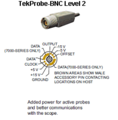Tekprobe BNC connector: Difference between revisions
mNo edit summary |
mNo edit summary |
||
| Line 8: | Line 8: | ||
a ×10 probe will connect this pad to ground through 11 kΩ, or short it to ground when the Identify button | a ×10 probe will connect this pad to ground through 11 kΩ, or short it to ground when the Identify button | ||
is pressed — see [[7000 series readout system]] for details). The smaller pads carry +15 V, +5 V and -15 V | is pressed — see [[7000 series readout system]] for details). The smaller pads carry +15 V, +5 V and -15 V | ||
power, an offset voltage supplied controlled by the mainframe, and a clock/data signal pair for serial | power, an offset voltage supplied and controlled by the mainframe, and a clock/data signal pair for serial | ||
communication between the mainframe and "smart" probes. | communication between the mainframe and "smart" probes. | ||
Revision as of 13:38, 9 January 2016

The Tekprobe BNC interface was introduced in 1986 and is widely used in 1990s Tektronix equipment to interface active probes (e.g. the P6243) to oscilloscopes.
It consists of a plain BNC connector that allows traditional BNC based connections such as from passive probes.
This connector is surrounded by contact pads carrying power and data. The two larger pad areas match the simple resistive readout pins on probes from the 7000 series scope generation (e.g. a ×10 probe will connect this pad to ground through 11 kΩ, or short it to ground when the Identify button is pressed — see 7000 series readout system for details). The smaller pads carry +15 V, +5 V and -15 V power, an offset voltage supplied and controlled by the mainframe, and a clock/data signal pair for serial communication between the mainframe and "smart" probes.
A similar standard exists based on SMA connectors, suitable for higher frequencies.
Used in
| Scopes | Plug-ins | Probes |
|---|---|---|
Pictures
-
Tekprobe connector (socket)
-
Tekprobe-BNC interface
-
Tekprobe plug


